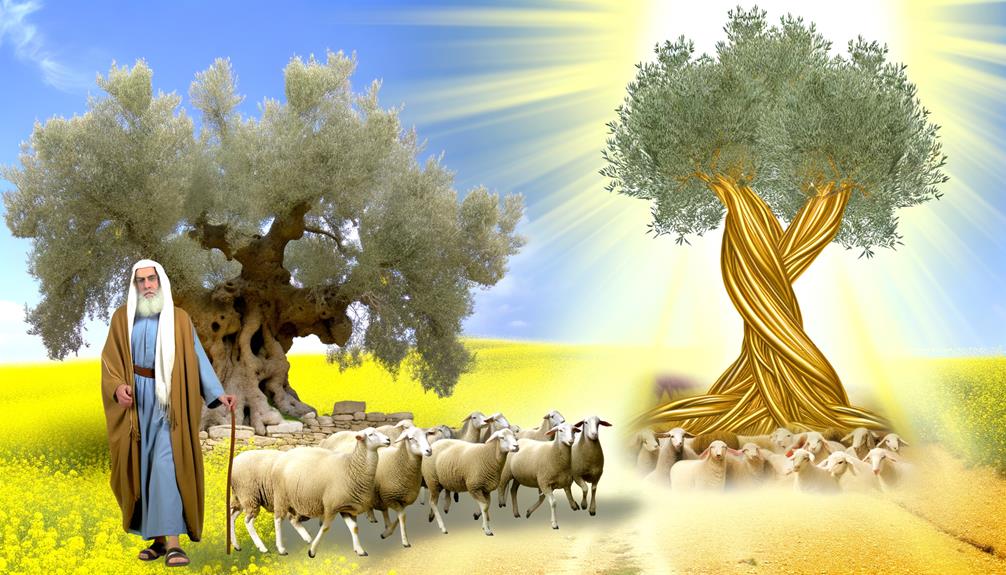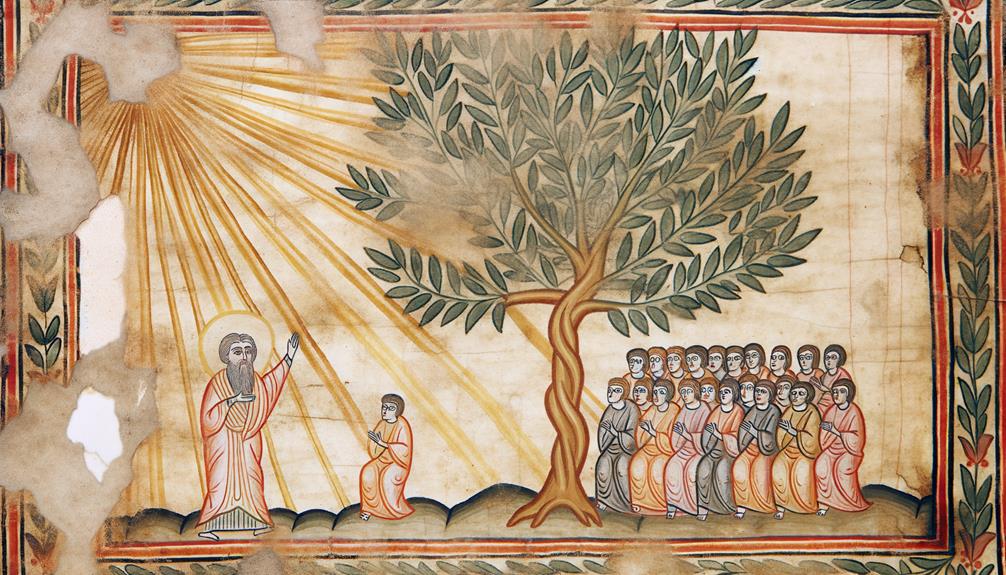Grafted Meaning In The Bible: Inclusion and Covenant
The concept of grafting in the Bible is a profound metaphor for spiritual inclusion, transformation, and unity. It symbolizes the integration of Gentiles into the spiritual lineage of Israel, as illustrated in passages like Romans 11:17-24.
This metaphor underscores themes of divine grace and the extension of God’s covenant beyond ethnic boundaries, emphasizing the transformative power of faith and community. Understanding this imagery provides deep insights into the theological foundations of the early Christian Church, illustrating how disparate groups can be unified in Christ.
To grasp its full significance, one should consider the cultural and scriptural contexts in which it appears.

Grafted Meaning in the Bible: Spiritual Inclusion and Unity in Christ
| Aspect | Biblical Insight |
|---|---|
| Definition | The act of joining or uniting, often used to describe inclusion into God’s covenant |
| Old Testament Reference | Jeremiah 11:16 – Israel as a green olive tree, later broken off |
| New Testament Reference | Romans 11:17 – “You, though a wild olive shoot, have been grafted in…” |
| Symbolism | Inclusion, unity, grace, and shared inheritance in Christ |
| Spiritual Application | Reminds believers of their adoption into God’s family and call to remain faithful |
Biblical Symbolism Overview

In the domain of biblical scholarship, symbolism serves as a profound tool for conveying complex theological concepts and spiritual truths.
The Bible employs a rich tapestry of symbols, ranging from concrete objects to abstract notions, enabling readers to grasp profound doctrines and esoteric wisdom. Symbols such as light, water, and bread are imbued with layers of meaning that transcend their literal interpretations, offering insights into divine attributes and human experiences.
This symbolic language bridges the finite and the infinite, inviting deeper exegesis and reflection. Understanding these symbols is essential for interpreting biblical narratives, as they often encapsulate moral, ethical, and eschatological themes, facilitating a more nuanced and thorough grasp of the sacred text.
Old Testament Examples

How do Old Scriptures examples of grafted symbolism illuminate the enduring theological themes embedded within the sacred text? The Old Covenant is replete with agricultural metaphors that convey deeper spiritual truths. These examples serve as conduits for understanding Israel’s relationship with God and the covenantal promises.
- Isaiah 5:1-7: The Vineyard of the Lord symbolizes Israel, showcasing divine expectation and human failure.
- Jeremiah 11:16-17: The Olive Tree represents God’s nurturing and the consequences of disobedience.
- Hosea 14:5-7: Israel depicted as a flourishing tree, reflecting restoration and divine blessing.
- Psalm 80:8-16: The Vine from Egypt illustrates God’s deliverance and subsequent judgment.
These metaphors underpin theological themes of judgment, redemption, and divine faithfulness.
New Testament Insights

The New Covenant extensively employs the concept of grafting to elucidate the inclusive nature of God’s kingdom and the extension of covenantal promises to both Jews and Gentiles. Grafting symbolizes the integration of Gentiles into the spiritual heritage of Israel, emphasizing unity in diversity within the body of Christ.
The Apostle Paul, particularly in Romans 11:17-24, uses this metaphor to illustrate how Gentiles, once ‘wild olive shoots,’ are grafted into the ‘cultivated olive tree’ of Israel. This theological construct highlights the continuity and fulfillment of Old scriptures promises through Christ.
| Scripture | Symbolism | Interpretation |
|---|---|---|
| Romans 11:17-24 | Grafting of olive branches | Inclusion of Gentiles into God’s covenant |
| Ephesians 2:11-22 | One new humanity | Unity of Jews and Gentiles in Christ |
| John 15:1-8 | Vine and branches | Dependence on Christ for spiritual energy |
| Galatians 3:28 | Neither Jew nor Greek | Equality and unity in Christ |
| Acts 10:34-35 | God’s impartiality | Acceptance of all who fear Him and do righteousness |
Parables and Metaphors

Parables and metaphors in the Bible serve as powerful rhetorical tools that convey complex theological concepts, including the theme of grafting, through vivid and relatable imagery. These literary devices simplify profound spiritual truths, making them accessible to diverse audiences. Jesus frequently employed parables to illustrate moral lessons and divine principles, imbuing everyday scenarios with deeper meaning.
- The Vine and the Branches: Symbolizes the interconnectedness between Christ and believers.
- The Good Shepherd: Reflects care and protection, mirroring God’s relationship with His followers.
- The Mustard Seed: Highlights growth from small beginnings to expansive faith.
- The Sower and the Seeds: Illustrates the reception of God’s word in different hearts.
These metaphors anchor abstract ideas into tangible experiences.
Cultural Contexts

Understanding the cultural contexts of biblical times is essential for interpreting the nuanced significance of grafting metaphors within Scripture.
In ancient agrarian societies, grafting was a familiar agricultural practice used to improve crop yield and fruit quality. This tangible process provided a vivid illustration for theological ideas.
For instance, the act of grafting, which involves the integration of a branch into a new tree, metaphorically represented the inclusion of Gentiles into the covenantal community of Israel.
Additionally, the cultural understanding of grafting underscored themes of transformation, unity, and continuity.
Recognizing these cultural nuances allows a deeper appreciation of how biblical authors employed grafting imagery to convey profound spiritual truths within their historical and socio-cultural framework.
Covenant Imagery

Covenant imagery in the Bible frequently employs grafting metaphors to illustrate the deep, transformative relationship between God and His people. This imagery underscores mutual commitment and spiritual renewal, reflecting the covenant’s enduring nature.
- Romans 11:17-24: Paul describes Gentiles as wild olive branches grafted into the cultivated olive tree, symbolizing their inclusion in God’s covenant.
- John 15:1-8: Jesus as the true vine and His followers as branches signify the necessity of abiding in Him.
- Jeremiah 11:16: Israel is depicted as a green olive tree, showcasing covenantal faithfulness.
- Ephesians 2:11-22: Gentiles and Jews unified through Christ, likened to grafted branches.
This covenantal grafting metaphorically encapsulates divine inclusion and spiritual unity.
Prophetic Messages

Prophetic messages in the Bible frequently employ grafting as a potent symbol to convey themes of restoration and inclusion.
This symbolism invites varied interpretations, particularly in the context of God’s covenantal promises and the integration of disparate communities.
Analyzing these prophetic texts offers a nuanced understanding of how grafting illustrates divine intervention and the fulfillment of eschatological visions.
Symbolism in Prophecy
In biblical prophecy, symbolism frequently serves as a complex and multifaceted tool that conveys deeper spiritual truths and divine messages. These symbolic representations often encapsulate profound theological insights and eschatological themes, providing believers with a rich tapestry of interpretive possibilities.
To illustrate this, consider the following elements commonly found in prophetic literature:
- Beasts: Represent empires or kingdoms, often characterized by their moral or spiritual attributes.
- Numbers: Specific figures like seven or forty carry significant theological implications.
- Colors: Employ hues such as white for purity or red for warfare and sin.
- Natural phenomena: Earthquakes, floods, and stars often symbolize divine intervention or judgment.
Understanding these symbols is essential for comprehending the intricate layers of biblical prophecy.
Interpretations of Grafting
Frequently, the concept of grafting in biblical texts symbolizes the integration of disparate groups into a unified spiritual community, reflecting themes of inclusion and divine covenant.
This metaphor, particularly evident in prophetic messages, underscores the extension of God’s promises beyond the original covenant community.
For instance, the Apostle Paul in Romans 11:17-24 employs grafting to illustrate Gentiles being incorporated into the spiritual lineage of Israel.
Such interpretations highlight a theological shift towards universality, emphasizing that divine grace and salvation transcend ethnic and cultural boundaries.
Consequently, grafting serves as a powerful prophetic symbol advocating for unity, inclusivity, and the fulfillment of divine promises across diverse peoples, reinforcing the overarching narrative of reconciliation in biblical prophecy.
Jesus’ Teachings

Jesus’ teachings, distinguished by their use of parables and analogies, offer profound insights into the nature of the Kingdom of Heaven and underscore principles of love and compassion.
His parables serve as didactic tools that convey complex theological concepts in accessible narratives.
These teachings not only frame the ethical and moral dimensions of Christian life but also provide a foundational understanding of divine grace and human responsibility.
Parables and Analogies
The parables and analogies employed by Jesus in the New Scriptures serve as profound vehicles for conveying complex theological truths in a manner accessible to diverse audiences. These narrative tools encapsulate ethical, spiritual, and moral lessons, embedding them within everyday scenarios familiar to first-century listeners.
Jesus’ use of parables serves several purposes:
- Simplification: Converts intricate divine concepts into relatable stories.
- Memorability: Guarantees teachings are easily remembered through vivid imagery.
- Inclusivity: Engages both the learned and the unlearned, transcending social barriers.
- Provocation: Stimulates critical thinking and self-reflection among listeners.
Kingdom of Heaven
Central to Jesus’ teachings, the Kingdom of Heaven represents a transformative vision of divine rule, characterized by justice, mercy, and the fulfillment of God’s will on earth. This concept redefines societal norms, emphasizing spiritual rather than material wealth, and urging believers to embody the principles of God’s kingdom in their daily lives. Jesus’ parables frequently illustrate the nature of this kingdom, challenging listeners to adopt a mindset of humility and service.
| Aspect | Description | Example from Teachings |
|---|---|---|
| Justice | Equity and righteousness | Parable of the Workers in the Vineyard |
| Mercy | Compassion and forgiveness | Parable of the Unforgiving Servant |
| Fulfillment | Realization of God’s will | Sermon on the Mount |
| Spiritual Wealth | Prioritizing spiritual over material riches | Rich Young Ruler |
| Humility & Service | Attitude of selflessness and servitude | Washing of the Disciples’ Feet |
Understanding these elements is essential to grasping the essence of Jesus’ message.
Love and Compassion
Integral to the teachings of Jesus, love and compassion function as foundational pillars that not only exemplify ethical conduct but also underpin the relational dynamics within the Kingdom of Heaven.
Jesus’ ministry frequently emphasized these virtues as essential to realizing divine will and human flourishing. His parables and actions reveal a nuanced, inclusive love, transcending cultural and societal boundaries.
- The Parable of the Good Samaritan: Illustrates unconditional compassion beyond ethnic and religious lines.
- The Sermon on the Mount: Advocates for love towards enemies and peacemaking.
- Healing Miracles: Demonstrate compassion through physical and spiritual restoration.
- The Prodigal Son: Highlights unconditional love and forgiveness.
These teachings remain critical for theological discourse and ethical practice within Christian communities.
Paul’s Letters

Paul’s letters offer profound insights into the theological concept of grafting, particularly in his epistle to the Romans.
In Romans 11:17-24, Paul employs the metaphor of an olive tree to illustrate the inclusion of Gentiles into the spiritual heritage of Israel. This imagery of grafting branches underscores the transformative process of unity and integration within the body of believers.
Paul’s analogy serves not only to explain the extension of God’s covenant but also to emphasize humility and dependence on divine grace.
By situating his argument within the broader narrative of salvation history, Paul adeptly synthesizes Jewish and Gentile identities, fostering a deeper understanding of communal belonging and divine election.
This rich, theological discourse remains pivotal in biblical exegesis and ecclesiology.
Modern Applications

Examining the concept of grafting within contemporary Christian practice reveals its enduring relevance in promoting inclusivity and unity among diverse faith communities.
Modern applications of this biblical metaphor underscore its potential to bridge doctrinal divides and foster communal harmony. Key areas where this theme is particularly pertinent include:
- Ecumenical dialogues: Encouraging conversations among different Christian denominations.
- Interfaith initiatives: Promoting understanding and cooperation between Christianity and other religions.
- Social justice movements: Addressing inequalities through a unified Christian front.
- Congregational diversity: Embracing members from varied cultural and ethnic backgrounds within local churches.
These applications highlight the dynamic ways in which the grafting metaphor continues to serve as a tool for fostering unity and inclusivity in modern Christian contexts.
Reflective Questions

Reflective questions about the grafting metaphor in the Bible can deepen our understanding of its theological and practical implications within contemporary Christian practice.
How does the concept of being grafted into God’s family inform our identity and sense of belonging within the Church?
What responsibilities arise from this grafted status, particularly in fostering unity and inclusivity among diverse congregations?
Additionally, how does this metaphor challenge individualistic interpretations of faith, urging a collective spiritual growth?
By contemplating these questions, Christians can explore the transformative potential of the grafting imagery, recognizing its call to a more integrated and compassionate community life.
Such reflections not only enrich personal faith but also promote a more interconnected and harmonious ecclesial existence.
Conclusion
The concept of being ‘grafted‘ in the Bible serves as a powerful metaphor for spiritual integration and communal belonging, transcending cultural and historical boundaries.
Through Old and New Scriptures examples, parables, and Paul’s letters, the theme underscores the transformative power of divine inclusion.
This idea resonates in modern applications, urging a reflective examination of faith and unity.
The biblical grafting narrative, much like a tree absorbing a new branch, enriches the collective understanding of divine acceptance.






